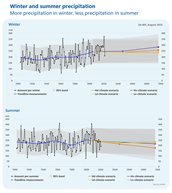Changing precipitation patterns and types (rain, hail, snow/ice)
This section includes information on the trends & projections of changing precipitation patterns and types, as well as precipitation and hydrological variability in the Netherlands.
Measurements by the Royal Netherlands Meteorological Institute (KNMI)(PDF) show that since 1906, annual precipitation in the Netherlands has increased by approximately 20%. In particular, winter has become considerably wetter, with a rise of around 30% in precipitation since the early 1900s. Autumn (+ 20%), summer (+ 10%), and spring (+ 5-10%) also experienced an increase in rainfall in the same period of time. Despite this overall rise, natural variations in rainfall remain substantial, reflecting the inherent variability of the hydrological cycle over time.
Climate change has a direct impact on precipitation patterns due to its influence on atmospheric dynamics. One key factor is the increasing capacity of the atmosphere to hold moisture (PDF): the atmosphere can retain approximately 7% more water vapor per degree of warming. This increased moisture content can lead to more intense rainfall, but the overall precipitation is potentially also influenced by shifting wind patterns. KNMI's 2023 climate scenarios project limited changes in future annual rainfall, but larger changes in seasonal variability.

Future projections: seasonal change in precipitation
Overall, KNMI projections of future rainfall in the Netherlands (PDF) show an increase in autumn, winter, and spring precipitation, while summer rainfall is projected to decrease. By 2100, the projected mean increase in total winter rainfall is 4-24% compared to 1991-2020, although large differences exist in the different climate scenarios. This anticipated increase in winter rainfall is driven by more westerly winds, which carry moist air from the Atlantic into the Netherlands. In contrast, summer precipitation is projected to decline across all KNMI climate scenarios. By 2100, the projected mean decrease in summer precipitation is set between 2% to 29% compared to 1991-2020. This reduction is associated with more high pressure and descending air in combination with more easterly winds that bring dry, continental air into the Netherlands.


